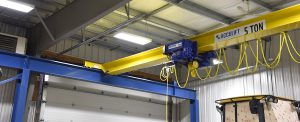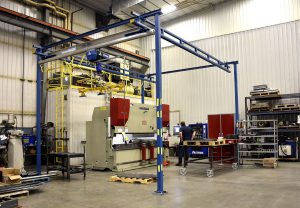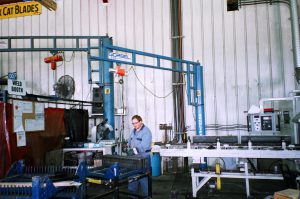
28 Aug What Manufacturer’s need to know about Overhead Cranes and Material Lifting systems
Plenty of metal fabricating operations have overhead cranes, but do plenty of those metal fabricating operations use the cranes to keep down overhead? Many of these companies may not be using the overhead cranes because they don’t know what they are fully capable of. In many instances, they may have come with the building and are used to picking up the occasional heavy load when a fork lift is available.
Actually, the forklift is the de facto means of moving steel material around a metal fabricating facility. Most shops have them, and training drivers takes only a few hours. but they aren’t welcome everywhere. Space is tight in many shops, and many other operations might be looking at their wide aisles as a potential home for a new machine tool or staging for work-in-process instead of a roadway for a forklift. And repetitive lifting with a forklift of materials is a slow process and is more prone to accidents – injuring employees and damaging materials.
That’s where an overhead crane can make a difference as the main means of material movement. Imagine a tool and die shop that’s served by one overhead crane that’s able to carry a load the length and width of the building and drop it off at a machining centre that’s served by its own, lighter-duty crane. The operator can control the loading and unloading of the tooling, depending on where it is in the manufacturing process.
Which crane types do metal fabricators use the most?

The most common type of overhead crane used in manufacturing environments is the overhead bridge crane. This crane runs on elevated tracks and is a popular choice because it offers hook motion along three axes—up and down, back and forth, and side to side. These cranes can run either on top of girders or be underhung.

Workstation cranes are another solution that we install in many manufacturing facilities. These column supported cranes can be installed in practically any facility as they are not dependent on the structure of the building. In addition to that benefit, they are modular and repositionable. If your processes change so can your lifting system.

The jib crane is another common sight in shops. These cranes feature a pivoting head and a boom assembly from which the hoist is attached. The base of the crane can either be floor-mounted, which provides 360-degree boom rotation or attached to a building column, which limits rotation of the boom to 180 degrees. Jib cranes are typically used for tool handling, single task lifting or for a specific workstation.
Monorail overhead lifting systems can be very effective when properly designed into a facility layout. Of course, such a crane has only two directions of hook travel—up/down and along the axis of the monorail beam—but that works for continuous-production environments, such as in painting operations. The downside to monorail systems is their inflexibility – if processes change it may require new monorail beams to be manufactured and installed.
The gantry crane operates in a similar fashion to the overhead bridge crane with the main difference being that it is supported on the floor, either connected to a set of tracks or on four wheels. A pair of steel legs support the bridge from which the hoist is connected. The big difference is that gantry cranes only have lifting capabilities up or down – they are not designed to move loads horizontally, that is, never move a gantry crane that is under load. For this reason, gantry cranes aren’t typically used in manufacturing processes.
The only time we would suggest a gantry crane is where you have a leased building and are unable to make any changes to the floor, walls, or ceilings.
The Crane Manufacturers Association of America (CMAA) classifies cranes according to starts per hour and the average percentage of full capacity being lifted, basically how often it is used and how hard it is being used:
- Class A for standby or infrequent service
- Class B for light service
- Class C for moderate service
- Class D for heavy service
- Class E for severe service
- Class F for continuous severe service
You can read more about the CMAA classifications here.
Class C and Class D cranes cover a majority of the equipment in the metals processing or manufacturing fields. Class C covers cranes that handle loads averaging 50 per cent of the rated capacity with 5 to 10 lifts per hour averaging 15 feet. At this classification level, not more than 50 per cent of the loads should be at rated capacity. Class D cranes are for loads approaching 50 percent of the equipment’s rated capacity and when those loads are handled constantly during the workday. Users of this type of equipment usually require about 10 to 20 lifts per hour averaging 15 ft. For Class D cranes, not more than 65 per cent of the lifts should be at rated capacity.
The CMAA describes both Class C and Class D as suitable for “machine shop” environments. While Class C would be appropriate for many shops. Class D would be better long-term as the components are much more robust.
What safety considerations need to be addressed with overhead cranes?
Crane safety always comes down to the training of operators. Want to know how well trained your crane operators are Ask a person operating a crane what the rated capacity is. Follow that up with a question about how much he is lifting at the moment. Correct answers for both reveal a very engaged employee. In all likelihood, the operator probably doesn’t know. Training can help them understand the importance of knowing what loads are safe and what loads are accidents waiting to happen.
What needs to be addressed before a crane is installed?
Without question, a company needs to consider just what the crane will be moving, how often it will be used, and how it will be supported. But Pelkola posed some other important questions:
What clearance—the distance from the floor to the lowest point in the building’s ceiling—is required to lift the necessary loads?
How high do you need the crane to lift?
What type of voltage rating is required?
We ask these questions and more to future-proof a lifting system. Inevitably clients are picking up something down the road that ends up being bigger than they anticipated. That’s why companies need to keep future load requirements in mind. Once a crane is installed and too little clearance exists between the bridge and the ceiling, a metal fabricator doesn’t have much choice but to raise the roof if it wants that crane to be modified to pick up larger loads than it was originally designed for.
Can old cranes be modernized?
One thing is sure about older overhead cranes: The manufacturers didn’t skimp on the steel. The bones that were suitable for the job 50 years ago are likely good enough for today.
The components, on the other hand, need to be replaced—end trucks, wheels, drives, motors, hoists, and electrical controls. A good modernization effort also will cover repainting, rewiring, and any needed repairs.
Modernization also provides an opportunity to upgrade the crane operations with new technological advancements.
The addition of variable-frequency drives for better speed control of the crane is a popular upgrade. The modern drive technology allows the operator to control acceleration and deceleration, rather than just getting one speed, with the single push of a button. This reduces the need for crane maintenance because components are not exposed to severe impact normally seen with outdated controls. Also, because the variable-frequency drives do not allow the operator to reverse plug or jog the crane, parts such as brakes, bearings, and drive trains last longer.
Radio remote controls are also a wise upgrade. An operator does not have to be close to the crane to operate it, with some control systems able to function within a range of a couple of hundred feet from the crane. There are established hand signals crane operators need to know when working with load assistants that can be downloaded here.
Handle With Care
Hopefully, you have picked up some knowledge about the overhead crane in your shop or the one you might be thinking about purchasing. This information doesn’t make you an expert, but it can help you become more informed on the subject and enable you to work more efficiently with the sales team at Acculift.
Our lifting experts are here for you.
Call us at (204) 837 8367 or Toll-Free at 1 888 317 8880 to speak to an Acculift lifting expert today.


